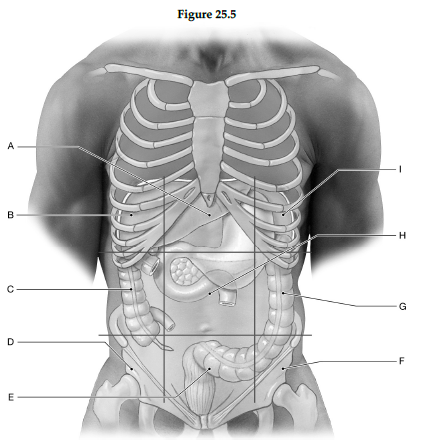Using the figure below, identify the labeled part.

1) Label A: ______________________________
2) Label B: ______________________________
3) Label C: ______________________________
4) Label D: ______________________________
5) Label E: ______________________________
6) Label F: ______________________________
7) Label G: ______________________________
8) Label H: ______________________________
9) Label I: ______________________________
1) Epigastric region
2) Right hypochondriac region
3) Right lumbar region
4) Right iliac region
5) Hypogastric region
6) Left iliac region
7) Left lumbar region
8) Umbilical region
9) Left hypochondriac region
You might also like to view...
Bill contracts a viral disease that destroys cells in the posterior gray horns in his spinal cord. As a result, which of the following would you expect?
A) loss of sensation in his torso B) inability to breathe C) problems with moving his arms D) uncontrollable sweating of his feet E) problems moving his legs
The greater the physical stress and compression to which a bone is subjected, the greater the rate of bone deposition
Indicate whether the statement is true or false
The connections between the nervous system and skeletal muscle allow for voluntary control of movement.
Answer the following statement true (T) or false (F)
Which of the following statements is true regarding the sodium-glucose transport protein (SGLP)?
A) It uses solvent drag to transport glucose and sodium. B) It is an antiport carrier. C) It is a uniport carrier. D) It transports glucose and sodium from the intestinal lumen into the epithelial cells. E) It transports glucose from the intestinal lumen into the epithelial cells, and sodium in the opposite direction.